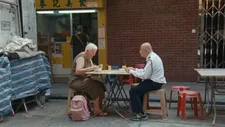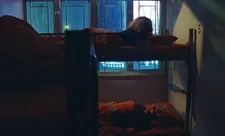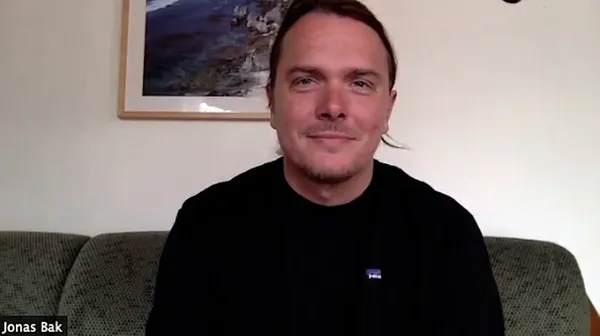 |
| Wood And Water director Jonas Bak on Anke Bak: “It was important to show the mother reminiscing about the past and maybe living more in the past than in the present.” |
Jonas Bak’s unhurried Wood and Water, starring his mother Anke Bak, is a highlight of the 50th anniversary edition of New Directors/New Films and will screen in the summer edition of the 71st Berlin International Film Festival. I see a thread developing from the ND/NF feature committee, as the Opening Night selection, Amalia Ulman’s El Planeta, also stars the director’s mother (Ale Ulman).
Bak’s debut feature with the help of remarkable, thought-provoking cinematography by Alexandru Grigoras, the music of Brian Eno, and a Chinese fortune teller, the nostalgia for “beautiful, quiet, normal family life,” shifts slowly into a different gear.
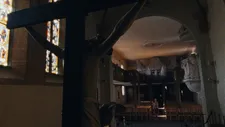 |
| Anke retires from her church job in a small picturesque town in the Black Forest. Photo: Trance Films |
Anke retires from her church job in a small picturesque town in the Black Forest. When her son Max, who moved to Hong Kong, is unable to join a family reunion by the Baltic Sea, where they used to spend time, mom decides to go visit him instead. “I never pray for things not to happen,” she confides in a new acquaintance she encounters in Hong Kong. As new people and places unfold for her, life opens up in its chaos and stillness. In a patient, almost imperceptible reversal of time, the protagonist seems like a little girl explorer in her shift dress, sandals, and rosy-pink backpack, out to discover the great big world for the very first time.
Anne-Katrin Titze: Hi, Jonas! Where in Germany are you?
Jonas Bak: In the South, in the Black Forest, very close to where we shot part of the film.
AKT: Where was that? Which town?
JB: Freiburg. It’s a student town, very south west.
AKT: How are things there right now with Covid?
JB: It’s alright. We’re safe here. We’ve got the forest, spending a lot of time outdoors. Starting this week, I think there’s another curfew, the numbers are pretty bad. But we’re picking up the vaccine speed. It’s much better than Berlin, though, I think.
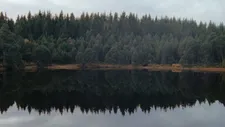 |
| Jonas Bak: “I would say, the legends around the forest, that’s also I guess a part of the film and part of where the mother finds refuge and peace for herself.” Photo: Trance Films |
AKT: So you are close to where your mother is?
JB: Yes, exactly.
AKT: You made a beautiful film. I was very impressed by the aftereffect it had, actually. It lingered. There’s something about the tempo, the pacing that has a great effect.
JB: Thank you. You’re the first one to say that, to talk about the lingering effect. It’s very nice. It’s a good sign if you think about a film. In slow cinema for me it’s always a bit of an effort and then a reward that only comes later on. You put in patience but you get more out of it maybe, that happens subconsciously while you watch it.
AKT: Towns, cities, places, forests, water - as it states in the title - are very important. The shot early on - is that Freiburg from above?
JB: No, that’s a really small town not far from here. We’re in a valley and there are little towns with about 5,000 inhabitants each. So it’s a small town that has very steep mountains around, so it’s easy to get this vista.
AKT: What’s the name of the town?
JB: It’s Wolfach.
AKT: Do I see a cat? Hi cat!
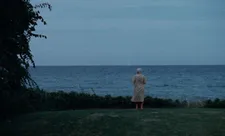 |
| Anke Bak looking out at the Baltic Sea Photo: Trance Films |
JB: Yes, it’s a cat [Elli].
AKT: The town looks so very very German and you have that shot from above. By this you subtly interweave German history into it, I thought. International audiences can’t help but think Leni Riefenstahl. Of course, then you go on a different journey. Was that something you were thinking about?
JB: It’s just because I’m from here, really. And it lends itself obviously. Also the forest, I would say, the legends around the forest, that’s also I guess a part of the film and part of where the mother finds refuge and peace for herself. But I didn’t look for this place, it’s just at my doorstep. We location scouted certain things, like the church and the town and maybe the road before she enters the tunnel to Hong Kong. There are things that are really just close by from here. It was about the contrast between rural Germany and Hong Kong. There are not many places in Germany that represent Germany maybe as well as around here.
AKT: That segue is beautiful of entering the tunnel and then she appears in Hong Kong. A wonderful shortcut that is so cinematic.
JB: That happened spontaneously because we couldn’t shoot the arrival in Hong Kong originally in the script, because the airport shut down because of the protests. We would have got permission but it wasn’t possible. So with this limitation I had to come up with some ideas. And I really liked the idea that the cinema would go black. The film would restart, the lights would go off again, a new wave, a new chapter washes over you when you enter Hong Kong. I liked that idea.
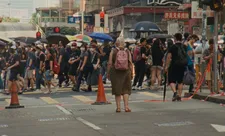 |
| Jonas Bak:“The attempt was to have this duality between the quiet rural life and busy loud hectic city life but kind of to seamlessly connect them …” Photo: Trance Films |
AKT: It works. The house by the Baltic Sea - I like very much how we first hear about the house, her with the daughter in the window and the little boy downstairs, and then we see the exact photographs - again a delay. Storytelling in two parts, first in words and then with images.
JB: This is taken from our life. These are our family photographs.
AKT: The little boy is you?
JB: Yeah, it’s me. It was important to show the mother reminiscing about the past and maybe living more in the past than in the present. Especially after the end of her working life, and to revisit those old places, but kind of be stuck there. So I liked the idea of reframing those old photographs but showing those places as they are now. You don’t get it straight away that these photographs are reframed. And we have her voice-over. To show a bit of the emptiness and this beautified space that you have in your mind that’s not there anymore. It’s about the process of letting go as well, this holiday of the past and those memories in a subtle way.
AKT: Where at the Baltic Sea were you filming?
JB: Near Aarhus by the Baltic Sea, the part that’s attached to Germany, second largest town in Denmark, and there’s a little seaside town just south of it where we used to go on holidays a lot. We had lived there when I was young, so we have lots of old photos from there and I just used that for the film.
AKT: Anke says “We’ve had a beautiful, quiet, and normal family life.” Three adjectives: beautiful, quiet, and normal. And then she embarks on a journey that is rather chaotic, not so quiet and I guess she rediscovers normal.
JB: The attempt was to have this duality between the quiet rural life and busy loud hectic city life but kind of to seamlessly connect them and kind of not polarize it that much. That was really the question - how do we portray Hong Kong? I wanted to make the places similar in a way through the form of the film. I wanted to link them up and also the memories. The film has a constant pace, it’s not all quiet and calm over Denmark and Germany and then suddenly in Hong Kong it erupts and we move fast through the story, it’s consistent throughout. That was my way of unifying the places in a way.
AKT: Unifying through the protagonist!
JB: Through her pace of going through life as well.
AKT: Is this your mother’s way of being? Did she slow down for the film? Or is the calm hers?
JB: It’s totally her. New Directors/New Films wrote something beautiful like “she gracefully travels from the Black Forest to Hong Kong.” But this grace is my mother. It’s her pace and the way she goes about things and the way she moves through life. It’s funny that you mention normal quiet family life, because she still has it now. It hasn’t changed much. The only difference is that in the film she’s alone, which is also not what she is in real life.
AKT: There are moments during her walks through Hong Kong when it feels as if time were reversing. She looks like a little girl. A little girl adventurer in her shift dress, her sandals, her hair cut short, and she has a pink backpack. Dora the Explorer discovering the world.
JB: That was planned I guess in a way. That childlike curiosity she still has now, we definitely used that in the film. Also this scene when she enters Hong Kong first with the younger woman in the hostel who is showing her, this is how young people travel. And she falls right into it. She doesn’t really get out of it and become an adult anymore. It’s also a way of being close to her son, by entering Hong Kong maybe the way he would have entered Hong Kong.
AKT: Even going further, when she has lunch with the doorman, they have these little boxed children’s drinks with a straw.
JB: That’s a nice detail you pick up on. That wasn’t planned. The backpack was definitely planned and the costumes as well to give it this cuteness. Make her adorable and approachable in a strange way.
AKT: You dedicated the film to your grandmother!
JB: Yes.
AKT: The grandmother we see at some point, don’t we? Is the mother saying goodbye to her mother before she leaves?
JB: It goes in a circle the older generation. My mother being 60 still gets a goodbye by my grandmother, another generation sill having the same kind of emotions. My grandmother wasn’t that well at the time when we made the film or afterwards, so I decided to dedicate it to her.
 |
| Wood And Water is a highlight of the 50th anniversary New Directors/New Films |
AKT: It was a moment that surprised me and confused me a little. It could have been the neighbor or a twin. German women of a certain generation resemble each other - the haircut, the furniture, the surroundings are very much alike.
JB: Yes, they are very much alike. They are mirrors of each other. Really incredible also in looks, I would say. I was hoping that it can be clear that it’s my mother’s mother. She used to say this a couple of years ago to my mother “Pass auf dich auf, Mädchen!” Look after yourself, be careful, my girl! I mean that tells you everything. That’s how a mother would say goodbye to a son, look after yourself.
AKT: Thank you!
JB: Thank you so much for the interview!
Coming up - Jonas Bak on the music of Brian Eno, the sound design, shooting the landscape, fortune teller research in Hong Kong, and a reflection.
Wood and Water screens on Friday, April 30 at 3:30pm; Thursday, May 13 at 3:15pm inside the Walter Reade Theater at Lincoln Center. There will be a pre-recorded post-screening Q&A.
The 2021 feature committee comprises Florence Almozini (Co-Chair, FLC), La Frances Hui (Co-Chair, MoMA), Rajendra Roy (MoMA), Josh Siegel (MoMA), Dan Sullivan (FLC), and Tyler Wilson (FLC), and the shorts were programmed by Brittany Shaw (MoMA) and Madeline Whittle (FLC).
New Directors/New Films at 50: A Retrospective is running free virtually through April 28.
The 50th anniversary edition of New Directors/New Films runs from April 28 through May 8 with the in-person screenings at Lincoln Center extended to May 13.








